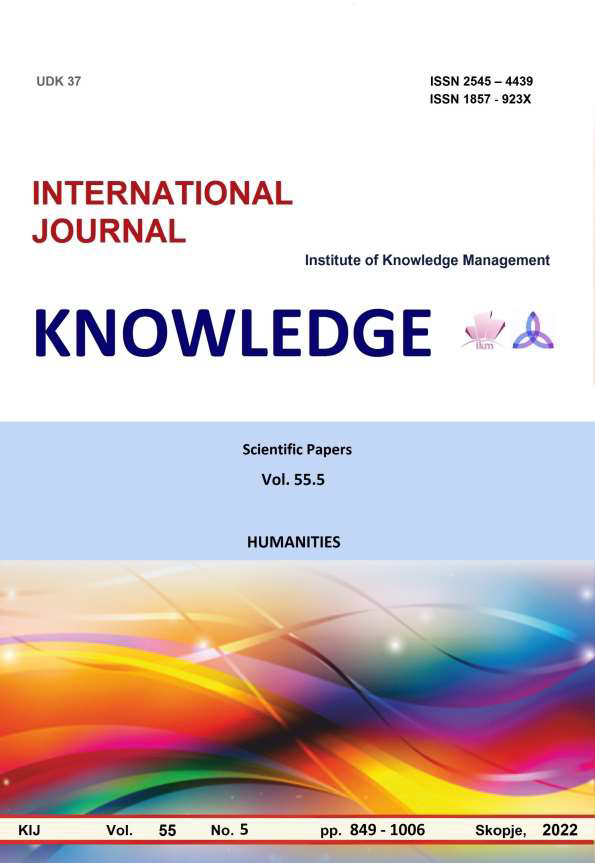TRUST BARRIERS TO INTERCULTURAL COMMUNICATION
DOI:
https://doi.org/10.35120/kij5505987vKeywords:
trust, barriers, intercultural communication, factors, relationshipAbstract
Trust is the lifeblood of all interpersonal and social relationships. Gaining and maintaining trust in
interpersonal relationships is a long and ongoing process that requires continuous investment. Many studies show
that people naturally react more strongly to dishonesty than to any other trait. One of the biggest causes of mistrust
is the different ways of looking at the world resulting from different typological orientations. Different personality
types are often not communicated on the "same frequency". Believing in people that they can do the best on their
own leads to greater inefficiency and dissatisfaction. Whether the message will be well understood depends on: the
content, the choice of certain signals, the way of communication, the form (the functioning of the verbal and nonverbal
communication system). There are many barriers to intercultural communication such as anxiety, stereotypes,
prejudice, non-verbal interactions, ethnocentrism, xenophobia, racism, discrimination and acceptance of similarities
instead of differences (Zhu, 2020, p. 1651-1655). Trust is a part of many factors. Reciprocity and the exchange of
information by revealing the factors that led to mistrust in intercultural communication are key elements in
maintaining relationships.
Trust is necessary because no one is independent of others, no one is self-sufficient, we are all interdependent in
terms of meeting basic needs. The overall characterization of trust as a complex, multifaceted phenomenon can be
classified according to different distinguishing criteria, primarily between interpersonal and institutional, vertical
and horizontal trust. Interpersonal trust refers to the belief that most people can be trusted, while institutional trust
includes trust in various institutions, such as the government, judiciary, health system, education system, media, etc.
Vertical means trust in public organizations (government, church, trade unions, etc.), and horizontally - trust
between people, independent of their various forms of social consciousness (custom, morality, religion), belonging
to macrosocial groups (nation, race, class) and of different social status (gender, age, education). The importance of
reputation is reflected in the fact that it is in a sense an investment, i.e. a resource that allows us to obtain other
important resources, among which is the trust of others and all the benefits that trust brings (Eisenegger, 2009, p. 11-
23).
References
Barna, L. (1994). Stumbling blocks in intercultural communication. In L. Samovar, R. Porter (ed.), Intercultural communication: A reader. Belmont, CA: Wadsworth.
Bennet, M. (2013). Concepts of intercultural communication (3-rd edition). John Murray Press
Bovee, Courtland L. (2012). Suvremena poslovna komunikacija. Zagreb: Mate d.o.o.
Dаnesi, M. (2006). Studies in Communication Sciences, “Ten principles of intercultural communication. Observations on Igor E. Klyukanov’s foundational text”, 6 (1).
Eisenegger, M. (2009). Trust and Reputation in the Age of Globalization. In J. Klewes and R.Wrechniok (eds.) Reputation Capital, Berlin: Springer.
Hofstede G. (2001) 'Culture's Consequences: comparing values, behaviours, institutions and organizations across nations',second edition, Thousand Oaks, CA.: Sage Publications.
Ilie, O. (2019). The intercultural competence. Developing effective intercultural communicationskills. International conference knowledge-based organization, 25(2).
Jalava, J. (2006). Trust as a Decision: The Problems and Functions of Trust in Luhmannian Systems Theory. Helsinki: Department of Social Policy, University of Helsinki.
Jayaswal, S. (2009). Barriers to intercultural communication. Pragyaan: Mass communication, abiannual Journal, 7(1).
Jones, G. R., & J. M. George 1998). The Experience and Evolution of Trust: Implications for Cooperation and Teamwork. The Academy of Management Review23 (3).
Merton, R. (1936). The Unanticipated Consequences of Purposive Social Action. American Sociological Review 1.
Mesić, M. (2006). Multikulturalizam: društveni i teorijski izazovi. Zagreb: Školska knjiga.
Radović, Cvetanović, Bojkov. (2008). Osnovi metodike javnog nastupa. Od misli do poruke. Deontološke i stilske odrednice, Talija izdavaštvo Niš i Institut za političke studije Beograd.
Samovar, Larry A., Porter Richard E., & McDanielEdwinR. (2013). Komunikacija između kultura. Naklada Slap, Zagreb.
Vreg, F. (1991). Demokratsko komuniciranje. Sarajevo: Narodna i Univerzitetska biblioteka BiH i Fakultet političkih nauka.
Zhu, S. (2020). A study on affective barriers in intercultural communication and relatedstrategies. Theory and Practice in Language Studies, 10(12).
Бойков, В., & Бойков. Д. (2019). Безмълвието в бизнес комуникацията, МВБУ, София.
Бойков. Д. (2019). Комуникацията като стратегия за управление на риска в кризисни ситуации на туризма, Шестнадесета международна научна конференция „Иновации и предприемачество в образованието и бизнеса“, Международно висше бизнес училище, Ботевград.
Бойков, В., & Тоцева, Я. (2016). Управление на бизнес комуникацията, Дилок, София.
Боянов, Б., & Бойков, В. (2021). Успехът не идва сам, МВБУ, София.
Палашев, Н. (2007). Да създаваш реалности, изд. За буквите, О писменехь, София





